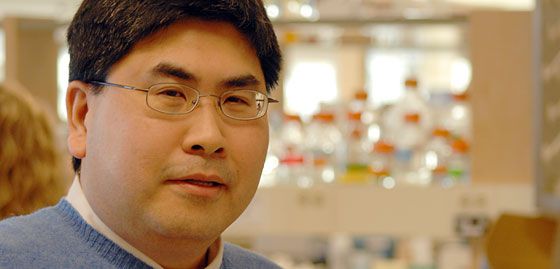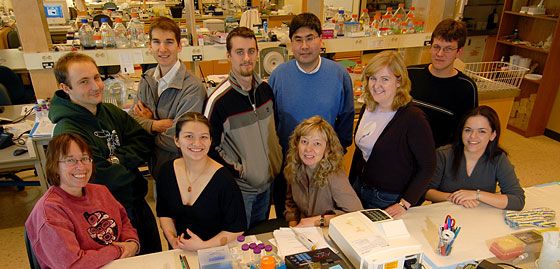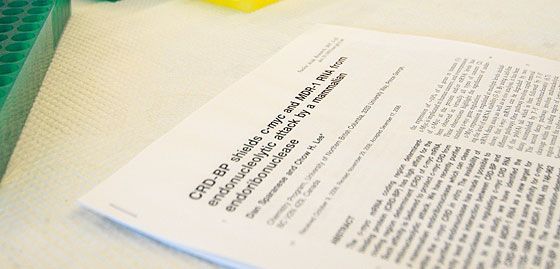
Dr. Chow Lee. Download the high-resolution image.
“The research has described how to destroy two aspects of cancer that make it so deadly."
After suffering the loss of his two-year old niece to leukemia, cancer had become very personal to Chow Lee. Then a 15-year old growing up in Malaysia, he decided to make a difference in cancer research. Now in Prince George, Dr. Lee has made an important discovery.
In a lab at the University of Northern British Columbia, Dr. Chow Lee and his team of student researchers finally have some exciting results after several years of experiments. But they didn’t make one important finding; they made three. Their results have just been published by a prestigious genetics journal from Oxford University Press, putting UNBC’s cancer research lab on the map. There’s a buzz in the lab on the upper floor of the Dr. Donald Rix Northern Health Sciences Centre. Dr. Lee and his team think they’re onto something, and the journal, Nucleic Acids Research (impact factor: 7.5), thinks they are, too.
In short, their research has described how to destroy two aspects of cancer that make it so deadly. At the same time, they have identified why it can be so difficult to treat.

Chow Lee (blue sweater) and his student research team. Download the high-resolution image.
DNA stores genetic information and messenger RNA (mRNA) carries the template that translates genes into proteins. Two of these proteins are known to make cancer cells aggressive: the c-myc protein, which is implicated in the rapid growth of cancer cells, and the MDR1 protein, which blocks the effectiveness of treatments such as chemotherapy. Basically, cancer cells produce too many c-myc and MDR1 proteins. Dr. Lee’s research is trying to understand how to control the mRNAs that lead to the production of c-myc and MDR1 proteins in cancer cells.
Another protein, called CRD-BP, is part of the story because researchers became aware that it could bind to several mRNAs, including c-myc mRNA, and prevent them from being destroyed.
The UNBC Findings:
- The UNBC team has been the first to identify a naturally occurring enzyme that can destroy both c-myc and MDR1 mRNAs.
- The UNBC team has been the first to prove that CRD-BP binds to MDR1 mRNA, thereby protecting the genetic material. This mRNA is used by cancer cells to produce lots of MDR1 protein, which enables the cancer cells to pump out chemotherapy drugs before they have a chance to work.
- The UNBC team has been the first to identify that the enzyme only works when CRD-BP isn’t already bound to the c-myc and MDR1 mRNAs.
“There are hundreds of thousands of different types of proteins but only a few hundred that are implicated in cancer,” says Dr. Lee. “We have focused on c-myc and MDR1 mRNAs for two reasons. First, these two are key to understanding why cancer cells are so aggressive. Second, we hope our results can be applied to other mRNAs which lead to the production of proteins also closely linked to cancer.” Proteins regulate most of the body’s biological functions and future UNBC research will continue to explore the link between CRD-BP, the naturally occurring enzyme, c-myc mRNA, and MDR1 mRNA in cancer cells.

The research paper. Download the high-resolution image.
“We’re really excited with what we have discovered, especially when you consider that this research mostly involved students and it was done entirely in Prince George,” adds Dr. Lee. “There are only three other cancer research teams in the world looking at the same proteins as we are, and those groups are in the US, Greece, and Denmark.”
Despite the discovery, Dr. Lee is quick to point out that a cure for cancer isn’t right around the corner. “These things take years. We think we’ve made a significant contribution, but our findings can only be demonstrated in a test tube, not in the body – at least not yet. If we continue having success with our research, we’ll eventually test our hypotheses in actual cancer cells.”
Dr. Lee remains focused on making a difference in cancer research. “I made a vow 27 years ago, and I’m as committed as ever.”
Dr. Lee's Bio
Chow Lee’s first exposure to cancer research occurred while he was enrolled in a bachelor’s degree program in Biochemistry and Physiology at the University of New South Wales in Australia. While completing his PhD at Flinders University, he conducted research on how certain chemicals stimulate the growth of cancer cells. In the early 1990s, he worked at the Ontario Cancer Institute in Toronto with Dr. Victor Ling, who discovered the MDR1 protein. That experience prepared him to join a cancer research lab at the University of Wisconsin-Madison, where purified an enzyme that can degrade c-myc RNA. He joined UNBC in 1998.
Radio Files
Dr. Lee says the next step will be to apply the research findings to cancer cells. (16s)
Dr. Lee describes how the two proteins impact various types of cancer. (20s)
Dr. Lee says it's significant that the research was done in Prince George with a UNBC student. (29s)
Video
Broadcast-quality video footage is available. Contact the Communications Office.
Additional Information
Biochemistry & Molecular Biology program - UNBC
Nucleic Acids Research journal
Contact:
Chow Lee
Associate Professor, Biochemistry and Molecular Biology
National Cancer Institute of Canada Research Scientist
PhD Flinders University, Australia
(250) 960-5413